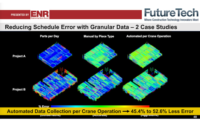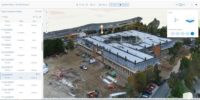
Emerging technologies, enhanced use of virtual design and construction, and automation are just some of the ways that construction is being transformed by optimizing efficiency.
Decision-making is fluid, projects are seamless, and quality is delivered on time and on budget. This is all possible because of the software and data management capabilities that result from effective planning, decisions, and structured data decisions.
Context
In the world of coding systems, structured data and organization opens new doors to innovations that allow for design and construction validation that was not possible in the past.
One of the ways VDC makes projects more efficient is by streamlining collaboration efforts. External collaboration is easier when key stakeholders can make design decisions and, with access to more information more often, are able to catch surprises and mistakes and make important changes long before problems arise.
BIM technology is largely the catalyst driving companies to streamline and improve existing processes. Using VDC allows design teams to capture emergent technologies and apply them to projects, saving money.
Cloud strategy, big data management, and BIM optimization — sometimes called “next generation BIM,” are the enabling technologies for more efficient projects. Project teams seek to serve industry stakeholders through these advancements while looking ahead, as things change so quickly, and that pace of change is becoming ever more rapid.
The construction industry is ripe for disruption and it comes in the form of new methods for gathering, sharing, and using data. While apps, plugins, data platforms, and dashboarding software are flooding the industry with promises of productivity and efficiency, other technologies, including reality capture, robotics and automation are on the horizon.
Optimizing VDC
One of the changes brought by the growing influence of VDC is a need for different expertise beyond the traditional engineering/design project team member. Computer science experts are key project team experts for the way they look at the world mathematically and algorithmically, with a heavy focus on data.
Such programmers are skilled in tool optimization and data connection and can help pave the way to automation and broader implementation of the right technology. To gain an edge over competition in the industry, it is critical to automate certain processes so that computers can do some of the simpler, routine tasks, and leave the critical thinking to people.
Leading project team experts are writing programs and custom applications to handle clash detection and design reviews. Additional applications export the data and offloads PDF printing, coordinating model collection, and clash detection.
In the ideal scenario, these are tasks that should be performed by project team experts every day. Automation via the right application of VDC tools now makes these tasks easier, and the capability is in place to build and automate on a basic platform. From there, valuable data is generated at a faster rate, so a visual dashboard as a tool to report out that data becomes key.
The next step after automation is to focus on machine learning. This is particularly applicable with generative design concepts, where the programmer teaches the computer to do something repetitive. For example, a building type that has been modeled the same way for the past 10 years can be modeled by a computer going forward.
To move forward into the world of automation, data standardization, predictive analytics, and eventually machine learning, a different project team member skill set is needed including creative problem solving with highly specialized technical expertise.
Benefits for Stakeholders
Changing the project team model is no small commitment, so leaders need to know there will be rewards for that effort. Tying everything back to the project bottom line and demonstrating that the project will be delivered on schedule and on budget is often enough to confirm this direction.
It also helps to align partnerships. With so much effort toward streamlining processes through Lean practices in the manufacturing industry, technology that helps stakeholders deliver on their goals and work more efficiently is appealing.
Stakeholders are enthusiastic about participating in 3D design review. While there are some sophisticated decision makers who can read drawings, piping and information diagrams, and traditional deliverables, they still enjoy the context and visuals a 3D environment provides.
Custom applications can help facilitate meetings when experienced project team leaders and experts are involved. In a design review, such project team members take the action items list for the project and create views inside the model, going through the list within the context of the model.
In this way, stakeholders can see how far along the project is via the model, and immersive 3D design reviews are a perfect opportunity to explore additional issues, or new design solutions, because of the cross-discipline context.
Every project discipline’s input to the model can be turned on in one location, rather than cross-checking multiple drawings, so it is much easier to see how things fit together. The ability to see everything in one place means that design teams can take stakeholders along on the journey, capturing their input during the process, rather than having decision makers focused only on the end deliverable with no insight into how it was achieved.
In one design review for a new platform in an operational facility, a stakeholder asked whether or not a forklift could fit between the platform column and the piece of equipment. While an on-site facility member went out to the shop floor to measure the space, the model manager found a forklift that was captured via scanning in the point cloud, clipped it out, and inserted it into the review model, showing that there was clearance. All this before the facility foreman returned to clear the project.
In the same discussion, a large drawer in a piece of equipment needed to be opened to perform maintenance. The model was able to show that the drawer was too large to be opened in the space, and a slight modification was planned at a critical moment.
The ability to get answers and make changes within minutes saves time and money and can be invaluable when teams are off site and can’t take physical measurements of a space. Beyond the initial project, reality capture data can be used from an operational maintenance standpoint. The data informs the way maintenance teams interact with the site and facility and enhances communication about operational efficiency.
In another example, a team designing a tower used a model created from reality capture data. They had planned to pour foundations in advance and build the tower later. Initially, the design placed the structure parallel to the building, but through reality capture, the team realized that the foundations would conflict with existing infrastructure.
During the meeting, the team used the model to pick up the schematic design and rotate it 90 degrees. Not only did the foundations fit with the new orientation, but no major infrastructure needed to be modified to accommodate the tower foundation. The ability to see these effects quickly and make decisions based on the findings has substantial impact in terms of the project schedule. Both these examples took place in plants that were operational, with no disruption to production — crucial to the bottom line.
Driving the Technological Transformation
When projects are delivered faster and with more precision, fewer change orders and expensive mishaps occur, therefore stakeholders need to embrace the technologies to remain competitive.
Early adopters are moving on to the next phase, with increased automation and machine learning that outsources the routine tasks to a computer and frees up people for more intellectually demanding tasks. This reallocation of resources is possible thanks to the capabilities of more advanced processes and software capabilities. The result is higher quality delivered faster and for less cost, benefits driving the cutting edge of the technological transformation.
Lauren Collier is the Department Manager, VDC Global Initiatives and Senior Associate at SSOE Group, a global project delivery firm for architecture, engineering, and construction management. Her creative passion lies in Lean, continuous improvements, and innovative model / data use solutions for design and construction operations. Lauren leads a group of VDC technical leaders and model managers whose focus is implementing new innovative technologies and best practices in design and construction. She can be reached in SSOE’s Toledo, Ohio, office at lauren.collier@ssoe.com





Post a comment to this article
Report Abusive Comment